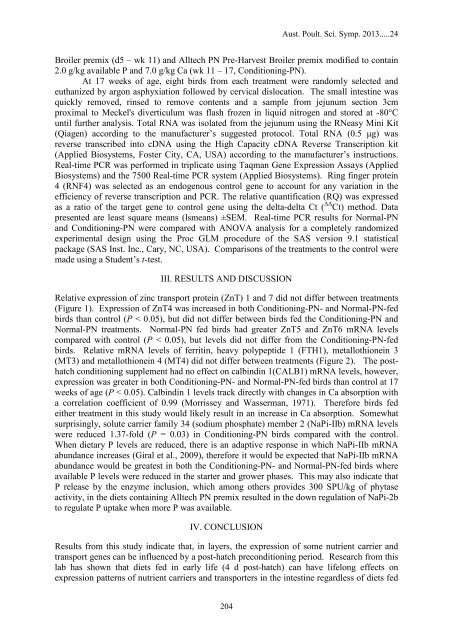APSS 2013 Proceedings - The University of Sydney
APSS 2013 Proceedings - The University of Sydney
APSS 2013 Proceedings - The University of Sydney
You also want an ePaper? Increase the reach of your titles
YUMPU automatically turns print PDFs into web optimized ePapers that Google loves.
Aust. Poult. Sci. Symp. <strong>2013</strong>.....24<br />
Broiler premix (d5 – wk 11) and Alltech PN Pre-Harvest Broiler premix modified to contain<br />
2.0 g/kg available P and 7.0 g/kg Ca (wk 11 – 17, Conditioning-PN).<br />
At 17 weeks <strong>of</strong> age, eight birds from each treatment were randomly selected and<br />
euthanized by argon asphyxiation followed by cervical dislocation. <strong>The</strong> small intestine was<br />
quickly removed, rinsed to remove contents and a sample from jejunum section 3cm<br />
proximal to Meckel's diverticulum was flash frozen in liquid nitrogen and stored at -80°C<br />
until further analysis. Total RNA was isolated from the jejunum using the RNeasy Mini Kit<br />
(Qiagen) according to the manufacturer’s suggested protocol. Total RNA (0.5 μg) was<br />
reverse transcribed into cDNA using the High Capacity cDNA Reverse Transcription kit<br />
(Applied Biosystems, Foster City, CA, USA) according to the manufacturer’s instructions.<br />
Real-time PCR was performed in triplicate using Taqman Gene Expression Assays (Applied<br />
Biosystems) and the 7500 Real-time PCR system (Applied Biosystems). Ring finger protein<br />
4 (RNF4) was selected as an endogenous control gene to account for any variation in the<br />
efficiency <strong>of</strong> reverse transcription and PCR. <strong>The</strong> relative quantification (RQ) was expressed<br />
as a ratio <strong>of</strong> the target gene to control gene using the delta-delta Ct ( ΔΔ Ct) method. Data<br />
presented are least square means (lsmeans) ±SEM. Real-time PCR results for Normal-PN<br />
and Conditioning-PN were compared with ANOVA analysis for a completely randomized<br />
experimental design using the Proc GLM procedure <strong>of</strong> the SAS version 9.1 statistical<br />
package (SAS Inst. Inc., Cary, NC, USA). Comparisons <strong>of</strong> the treatments to the control were<br />
made using a Student’s t-test.<br />
III. RESULTS AND DISCUSSION<br />
Relative expression <strong>of</strong> zinc transport protein (ZnT) 1 and 7 did not differ between treatments<br />
(Figure 1). Expression <strong>of</strong> ZnT4 was increased in both Conditioning-PN- and Normal-PN-fed<br />
birds than control (P < 0.05), but did not differ between birds fed the Conditioning-PN and<br />
Normal-PN treatments. Normal-PN fed birds had greater ZnT5 and ZnT6 mRNA levels<br />
compared with control (P < 0.05), but levels did not differ from the Conditioning-PN-fed<br />
birds. Relative mRNA levels <strong>of</strong> ferritin, heavy polypeptide 1 (FTH1), metallothionein 3<br />
(MT3) and metallothionein 4 (MT4) did not differ between treatments (Figure 2). <strong>The</strong> posthatch<br />
conditioning supplement had no effect on calbindin 1(CALB1) mRNA levels, however,<br />
expression was greater in both Conditioning-PN- and Normal-PN-fed birds than control at 17<br />
weeks <strong>of</strong> age (P < 0.05). Calbindin 1 levels track directly with changes in Ca absorption with<br />
a correlation coefficient <strong>of</strong> 0.99 (Morrissey and Wasserman, 1971). <strong>The</strong>refore birds fed<br />
either treatment in this study would likely result in an increase in Ca absorption. Somewhat<br />
surprisingly, solute carrier family 34 (sodium phosphate) member 2 (NaPi-IIb) mRNA levels<br />
were reduced 1.37-fold (P = 0.03) in Conditioning-PN birds compared with the control.<br />
When dietary P levels are reduced, there is an adaptive response in which NaPi-IIb mRNA<br />
abundance increases (Giral et al., 2009), therefore it would be expected that NaPi-IIb mRNA<br />
abundance would be greatest in both the Conditioning-PN- and Normal-PN-fed birds where<br />
available P levels were reduced in the starter and grower phases. This may also indicate that<br />
P release by the enzyme inclusion, which among others provides 300 SPU/kg <strong>of</strong> phytase<br />
activity, in the diets containing Alltech PN premix resulted in the down regulation <strong>of</strong> NaPi-2b<br />
to regulate P uptake when more P was available.<br />
IV. CONCLUSION<br />
Results from this study indicate that, in layers, the expression <strong>of</strong> some nutrient carrier and<br />
transport genes can be influenced by a post-hatch preconditioning period. Research from this<br />
lab has shown that diets fed in early life (4 d post-hatch) can have lifelong effects on<br />
expression patterns <strong>of</strong> nutrient carriers and transporters in the intestine regardless <strong>of</strong> diets fed<br />
204
















